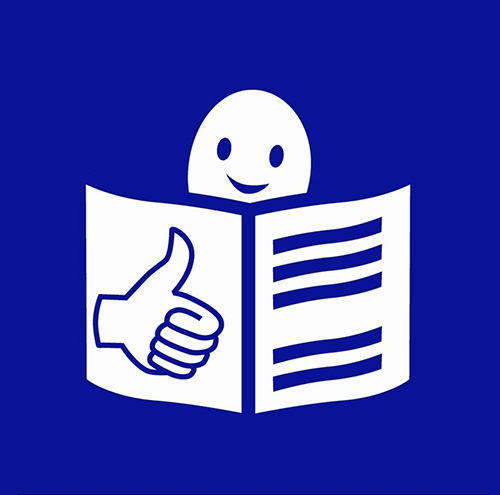
The Sudeten German Museum has lots of information for its visitors.
Our aim:
You can quickly find the information you need.
So we have listed
information for you here.
You can simply click on a word in the list.
That will take you straight to this information.
This is the list:
Welcome to the Sudeten German Museum.
This website gives you important information
about our museum.
You need this information when you visit our museum.
Our museum is open from Tuesday to Sunday.
The museum is then always open from 10 am to 6 pm.
But you must be here by 5:30 pm at the latest.
We cannot let you in after that.
Because you will not have enough time to look at everything.
Our museum is closed every Monday.
Our museum is also closed on these days:
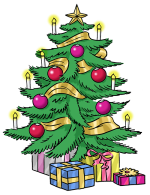
You need a ticket for our museum.
That means you have to pay to
visit the museum.
These are our prices:
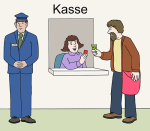
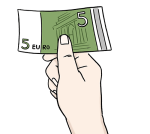
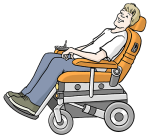
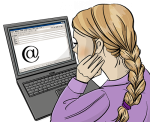
You want to book a guided tour?
Please use this email address to do so:
anmeldung@sudetendeutsches-museum.de
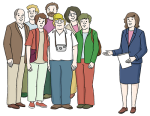
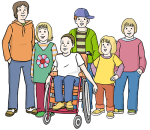
You can buy tickets at the museum pay desk.
Or buy them from our online shop.
You will find our online shop on our website.
You can click on it there.
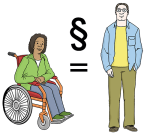
You can get here in different ways.
Here are more details on the ways:
Take the S-Bahn.
S-Bahn is short for Schnell-Bahn.
Schnell-Bahn is German for fast train.
Please travel to the stop called Rosenheimer Platz.
Then get off.
And take the exit marked Hoch-Straße.
Take the tram:
A tram is a train that travels on rails on the road.
Please take tram number 25 to the stop called Rosenheimer Platz.
Then get off.
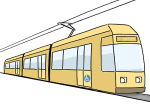
By car:
Are you coming by car?
Then you should park in the car park.
The car park is by the Holiday Inn hotel.
The car park is not free.
That means:
You have to pay money to park there.
This is the address of our museum:
Sudetendeutsches Museum
Hoch-Straße 10
81669 München
Germany
Email:![]() info@sudetendeutsches-museum.de
info@sudetendeutsches-museum.de
![]() Phone: +49 89 – 48 00 03 37
Phone: +49 89 – 48 00 03 37

You should not bring larger objects to our museum.
You can hand in these objects at the coat check.
We mainly mean these objects:
Please also be considerate to other visitors.
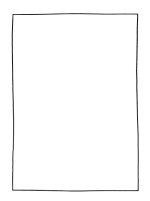
You may take photos in the museum.
But you must switch off the flash in your camera.
And you must not use a tripod.
A tripod is a stand for a camera.
You may only use the photos for personal use.
This means:
You may show your photos to your family, for example.
But you must not sell your photos to other people.
Please make sure that your phone does not ring.
When you visit our museum.
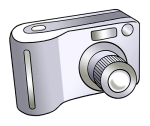
You can bring small dogs to the museum.
But you must use a dog cart for the dogs.
A dog cart looks almost like a pram.
You can use a dog cart from the museum.
Guide dogs may enter the museum.
Do you have questions about your visit to the museum?
Or about guided tours?
Then please write us a message.
The easiest way is to use the contact form on our website.
We will answer you as quickly as possible.
And answer your questions.
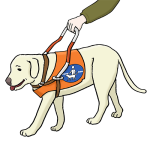
Our museum is accessible.
That means you can get everywhere in a wheelchair.
And there is a toilet
for people with disabilities.
We also have tactile guide tracks.
These help blind people.
And people who cannot see much.
People can feel if they are walking on the right path.

We also have audio stations
in our museum.
There you can listen to texts.
And don’t have to read them yourself.
We also have a media guide.
This is a small device with earphones.
You can hang the media guide around your neck.
You can also watch information there in sign language.
You can get the media guide at the reception.
The reception is by the entrance.
You can also go there if you have questions.
We also have tactile stations.
There you can touch objects, for example.
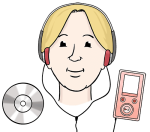
There is a museum shop at the entrance.
There you can buy things that go with our museum.
Examples could be books and films.
You can also buy these things from our online shop.
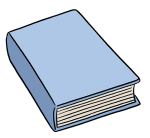
There will soon be a museum cafe in the museum basement.
You can buy food and drink there.
For example coffee and cake.
But the museum cafe is not open yet.
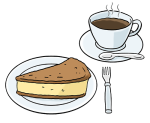
When you send us a message.
We take great care of your personal data.
That means:
We do not share your data with other people.
Examples of personal data:
You can write us a message on our contact form.
Then you have to accept a data protection declaration.
That means:
You agree that
we can have your personal data.
We need these data to
answer your questions, for example.
But you can always change your agreement.
That means:
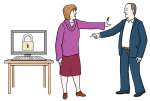
You can say later that you no longer agree.
Then we will delete your data immediately.
Do you want to change your agreement?
Then please use this email address:
info@sudetendeutsches-museum.de

By digital offers we
mainly mean offers on our website.
That means you can also find out about our museum on your computer.
You can also do this from home.
For example: You can watch videos about the museum.
You will find more information about this on our website under Digital programme.
But this page is not available in easy language yet.
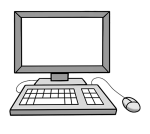
Our museum belongs to the Sudeten German Foundation.
And we also get money from StMAS.
StMAS is short for:
Staats-Ministerium für Familie, Arbeit und Soziales.
This is the State Ministry for Family, Labour and Social Affairs.
The ministry is part of the government of Bavaria.
At our museum you can experience the homeland in a new way.
This is the homeland of the Sudeten Germans.
The Sudeten Germans come from Bohemia,
Moravia and Sudeten-Silesia.
These places are now in Czechia.
Czechia is a neighbour country of Germany.
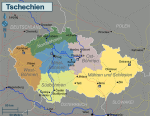
The native language of Sudeten Germans is German.
A native language is a language you learn from birth.
Most Sudeten Germans now live in Germany.
This is because of the end of World War 2.
That was in 1945.
At that time the Sudeten Germans had to leave their homeland.
The government of Czechoslovakia said:
The Sudeten Germans must leave Czechoslovakia.
At that time Czechoslovakia was the name of the state
where the Sudeten Germans lived.
State is a different word for country.
This country does not exist anymore.
Today it is two states:
Czechia and Slovakia.
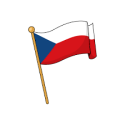

The Sudeten German Museum has a lot of information about the Sudeten Germans.
For example you can find out how people used to live there.
You will also see many objects from that time.
By objects we mean photos and letters, for example.
Also painted pictures and drawings.
You can also listen to music from that time.
The objects belong to the art and culture
of the Sudeten Germans.

The museum has a big exhibition.
The exhibition shows how the Sudeten Germans lived.
It looks back on 1100 years of history.
That is how long Sudeten Germans lived there.
That is a very long time.
The permanent exhibition at the museum is called: Homeland.
The Sudeten German Museum explains:
How the Germans lived in Bohemia,
Moravia and Sudeten‑Silesia.
Those are the 3 areas where the Sudeten Germans lived.
These areas are now part of Czechia.
The exhibition is split into three topics.
These are the topics:



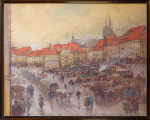
Germans, Czechs and Jews lived together in the past.
That was special about Bohemia, Moravia and Sudeten-Silesia.
The Sudeten German Museum explains this history.
The museum also shows:
That is what the homeland was like.
It was a special homeland in Europe.
The reason was:
All these people shaped their own homeland.
That means:
They had their own songs and dances, for example.
And cooked food with their own recipes.
The special term for this is cultural landscape.
This cultural landscape is important for all of Europe.
The Sudeten German Museum has a lot of information
for visitors.
Every piece of information has been checked.
That means:
Employees of the museum checked:
Was it really like that?
The museum worked with many experts on this.
These experts are called scientists.
The museum uses modern aids.
This means films and audio recordings, for example.
An audio recording can be a speech by a politician, for example.
You can listen to an audio recording.

The building is also very modern.
It looks very special.
And remains in your memory.

Translated by sag’s einfach – Büro für Leichte Sprache, Regensburg.
Checked by the test group einfach g`macht, Abteilung Förderstätte,
Straubinger Werkstätten St. Josef der KJF Werkstätten g GmbH.
The pictures come from © Lebenshilfe für Menschen mit geistiger Behinderung Bremen e.V., Illustrator: Stefan Albers, Atelier Fleetinsel, 2013 and from © Inga Kramer, www.ingakramer.de (woman on laptop).
© European Easy-to-Read Logo: Inclusion Europe. More information at https://www.inclusion-europe.eu/easy-to-read/
Follow us on:
Facebook
Instagram
Youtube
Tripadvisor
Sudetendeutsches Museum
Hochstraße 10
81669 München
Germany
Tel.: +49 89 480003 37
The sponsor of the Sudeten German Museum is the Sudeten German Foundation.
The Sudeten German Museum is supported by funding from the Bavarian State Ministry for Family, Labour and Social Affairs.